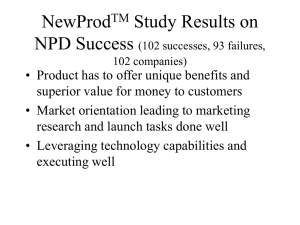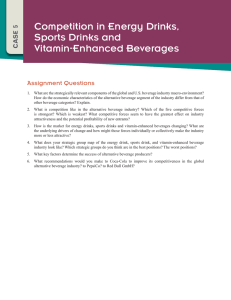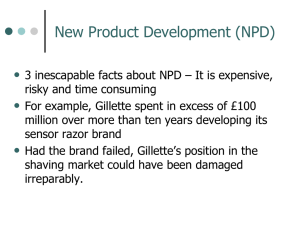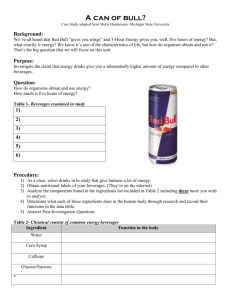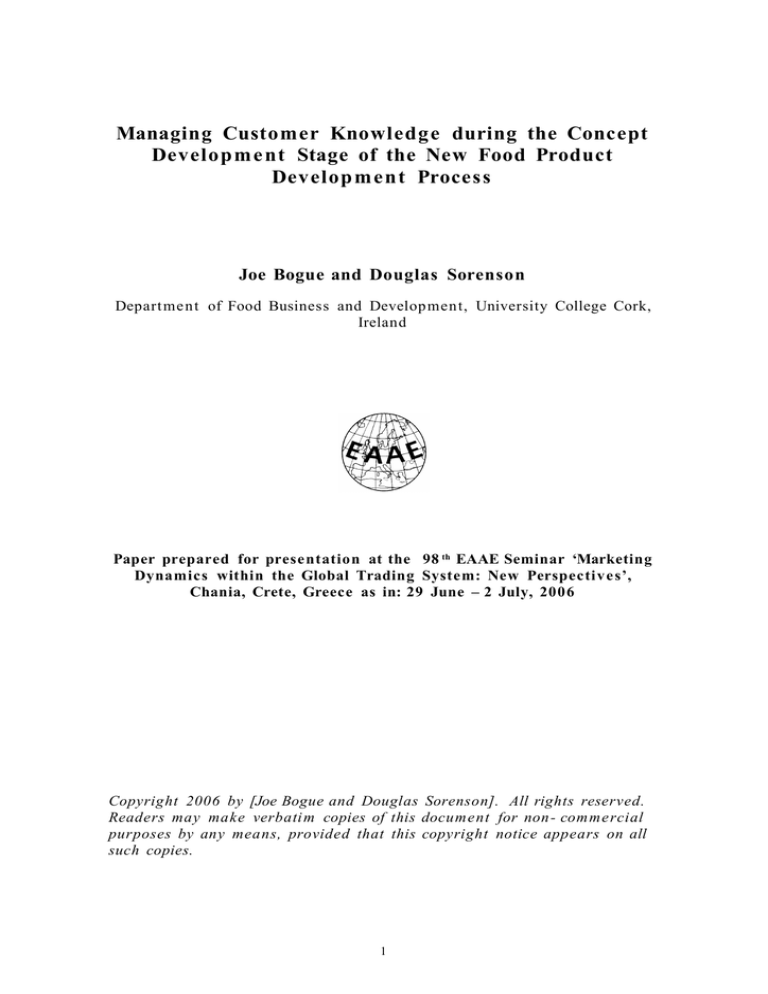
Managing Customer Knowledge during the Concept
Develop m e nt Stage of the New Food Product
Develop m ent Process
Joe Bogue and Douglas Sorenson
Department of Food Business and Development, University College Cork,
Ireland
Paper prepared for presentation at the 98 th EAAE Seminar ‘Marketing
Dynamics within the Global Trading System: New Perspective s’,
Chania, Crete, Greece as in: 29 June – 2 July, 2006
Copyright 2006 by [Joe Bogue and Douglas Sorenson]. All rights reserved.
Readers may make verbatim copies of this document for non - com mercial
purposes by any means, provided that this copyright notice appears on all
such copies.
1
2
Managing Customer Knowledge during the Concept
Develop m e nt Stage of the New Food Product
Develop m ent Process
Joe Bogue a,1 and Douglas Sorenson a
Departme n t of Food Business and Development, University College Cork a
Abstract. New product developme nt (NPD) is a knowledge intensive process where the generation of
new ideas and concepts requires detailed knowledge of both products and customers. The high
reported failure rates for innovative functional beverages suggest an inability to manage customer
knowledge effectively, as well as a lack of knowledge manage m e nt between functional disciplines
involved in the NPD process. This research explored the concept of managing customer knowledge
at the early stages of the NPD process, through the use of advanced concept optimisation methods,
and applied it to the developme nt of a range of functional beverages. A conjoint - based survey was
administered to four hundred customers in Ireland. This research identified two hypothetical
functional beverage concepts with high levels of customer acceptance. Managing customer
knowledge during the concept development stage of the NPD process can assist firms overcome
customer acceptance issues associated with innovative products. Methodologies that advance both a
firm’s understanding of customers’ choice motives and value systems, and its knowledge
manage m e nt process, can increase the chances of new product success in international food and
beverage markets.
Keywords: Knowledge Management, New Product Developme nt, Functional Beverages.
1. Introduction
1.1. Knowledge managem e nt and new product succes s
Organisations require information from both internal and external sources to evaluate
and monitor business activities as well as make informed business decisions.
Consequently, knowledge is widely considered one of the most important intangible
resources that firms can possess, and is considered essential to the development of
organisations [1]. However, knowledge can only become an asset to a firm if it is
enhanced, managed and effectively used [2]. In that context, knowledge management is
the management function that creates and manages the flow of knowledge within an
organisation, and ensures that knowledge is used effectively and efficiently for the longterm benefit of an organisation [3]. New product development (NPD) is considered a
knowledge intensive process where the generation of new ideas and concepts requires
detailed knowledge of both products and customers. The multi - disciplinary nature of
the NPD process therefore necessitates the generation, dissemination and management
of knowledge across all functions involved in the development of new products. Indeed,
knowledge management is now widely considered a key factor for NPD success [4, 5, 6] . It is
believed that effective knowledge management can lead to higher levels of integration
and knowledge transfer between functional disciplines, and thereby promote a more
flexible and efficient multi- disciplinary NPD process on which a competitive advantage
can be built and sustained [7, 8]. More so, effective knowledge management is regarded as
an extremely important tool within organisations for the promotion of creativity where
several researchers have reported a strong relationship between knowledge - based
organisations, creativity in idea generation and new product success [9, 10, 11, 12] .
Importantly, the key dimensions of knowledge management orientation, namely
knowledge generation and knowledge dissemination, are considered key dimensions of
1 Corresponding
j.bogue@ucc.ie.
author. Tel.: +353
21 4902355; Fax: +353
3
21 4903358; Email:
market orientation [13, 14] . So how can firms manage knowledge more effectively during
the new food product development process?
1.2. Managing custom er
developm e nt proces s
knowledge
in
the
new
food
product
The early stage of the NPD process is the period when new product opport unities are
first considered and move through the stage - gate NPD process for further development.
These front - end activities are believed to be inter - related, and that an oversight in
relation to front - end activities can lead to product failure [15] . Uncertainty is therefore an
inherent characteristic of the NPD process, in terms of identifying concepts that are most
promising, and whether new concepts can gain customer acceptance. Consequently, p oor
knowledge management at the early stage of the NPD process can result in both product
design and customer acceptance problems arising in the later stages of the NPD process,
where development costs incurred can be extremely high [16] . The early stage of the NPD
process therefore present s an opport unity to create value with, rather than for, the
customer. Seeing as customers are the final stakeholders and arbiters of new products,
involving customers at the early stage of the NPD process would be expected to reduce
the uncertainty associated with the process of product development. In that sense,
market orientation is considered the most efficient means of managing customer
knowledge, as market - oriented firms are considered proficient at gathering and
disseminating information and knowledge [13, 14] .
The incorporation of customers’ value - creation at the early stage of the NPD process is
believed to make organisations better able to adapt to changes in customers’ needs [17] .
This ultimately leads to the creation of a deeper relationship with the customer and
creates more effective and efficient opportunities for acquiring knowledge, and
ultimately leads to higher levels of quality and customer satisfaction [18] . In new food
product development the customer has an extremely important role to play at the
concept development stage of the NPD process in two respects: the customer as a
resource, and the customer as co- designer in NPD [19] . In market - oriented organisations
customers are viewed as significant co- designers since they can make an effective
contribution to product design and acceptability [20, 21] . In effect, it is believed that the
integration of customers with the multi- disciplinary NPD process can bring NPD
practitioners closer to understan di ng customers’ needs and wants [22] . Consequently,
market - oriented firms, which promote inter - depart me nt al co- ordination, would be
expected to have a clear understan ding of customers’ needs, manage knowledge more
effectively and efficiently, develop superior new products and services to meet their
needs, and therefore, positively influence the degree of innovation in firms [23] .
Importantly, integration between functions and customer knowledge management can
both be facilitated during the concept development stage of the NPD process through the
use of advanced concept optimisation research techniques such as focus groups,
conjoint analysis and sensory analysis [20, 22] . However, uptake of formal concept
optimisation research methodologies across sectors and industries remains low or is
applied in an ad- hoc fashion [24, 25] . Gathering customer information through formal
concept optimisation research methods results in information that can be more easily
disseminated throughout the organisation [14] . More importantly, advanced concept
optimisation research methods facilitate closer integration between technical Research
and Development (R&D) and marketing functions in the new food product development
process, which is a key factor for new product success [26] . This market - oriented
approach to NPD can help ascertain the feasibility and level of market acceptance of new
product concepts, define target customer groups, and identify the optimal extrinsic and
intrinsic attributes driving customers’ preferences and acceptance of innovative foods
and beverages [22, 27] . Strategic reviews of food and beverage industries worldwide
consistently emphasise the need for firms to improve their innovation and marketing
4
capabilities, in order to maintain competitiveness in both domestic and overseas
markets. In particular, the functional food and beverages market has been singled out as
an extremely important emerging market, which firms could benefit from through an
increased technological and market orientation.
1.3. New product develop m ent in the functional food and beverages
market
Firms require a knowledge management process that is both dynamic and flexible, and
which can respond to changes to a firm’s innovation strategy [28] . In particular, it is
argued that the management style, and the importance of knowledge management and
knowledge dissemination to innovation, depends upon the type of innovation pursued by
a firm [29, 30] . Specifically, knowledge management is considered extremely important to
technology- oriented NPD strategies due to the high level of risk associated with radical
innovations, such as functional food and beverages, where firms need to manage
knowledge more effectively in order to stay close to customers [31, 32] . Indeed, functional
foods and beverages can be characterised as radically innovative or ‘breakthrough’
product s that on one hand provide value to customers, in terms of their inherent health
benefits, while on the other hand potentially deliver long- term profitability and
competitive advantage in the marketplace [33, 34] . The functional food and beverages
market has therefore come to represent an extremely important strategic and
operational orientation for food and beverage, biotechnology and pharmaceutical firms,
as a result of changing market dynamics and customer trends [33, 34, 35] . However, these
emerging new product categories present considerable challenges to firms in terms of
identifying and developing technological ‘breakthrough’ products on one hand, and the
marketing of science and technology to customers on the other. In fact, while
‘breakthrough’ products potentially offer value or benefits to customers over incumbent
product s, customer acceptance of novel ‘breakthrough’ products is considered slower
than for conventional products [36] .
It is reported that approximately 70 to 90 per cent of new functional food and beverages
fail within the first year, which can be attributed to: poor customer acceptance from both
a marketing and sensory perspective; efficacy and legislative issues concerning
functional food labels; poor customer education; incorrect pricing, promotion and
positioning strategies; and ineffective market segmentation [37, 38, 39, 40] . In fact, it is argued
that many functional food and beverage firms rely solely on the functionality or health
benefits, and neglect other unique selling point factors such as aspects of sensory appeal
or convenience, in order to gain a competitive advantage in the food and beverages
market [37, 41, 42, 43] . In particular, it has been shown that even though functional beverages
offer health benefits, off- flavours can act as a deterrent to customer acceptance,
especially when beverages lose their refreshm en t and pleasure appeal [44, 45] . Not
surprisingly, for technology- oriented firms, a differentiation strategy based solely on
functionality and associated health benefits offers a short - term competitive advantage
only: “often technology is used to create value for the producer and this can sometimes be
a very different matter from creating customer value ” [46] . These insights into the
development and strategic marketing of functional foods and beverages would suggest
that customer acceptance issues at this early stage of the NPD process are either ignored
or poorly understood by firms, resulting in organisational failure to manage customer
knowledge effectively, as well as a lack of knowledge management between disciplines
involved in the NPD process [41, 47] .
Consequently, this research explored the concept of managing customer knowledge at
the concept development stage of the NPD process, through the use of advanced concept
optimisation research techniques, using the development of gut benefit juice- based
functional beverages as an example. Gut benefit juice- based functional beverages were
chosen for this study as juice manufacturers were considered to lead NPD activities for
gut benefit non - dairy beverages as line extensions of existing functional drinks, with gut
5
benefit juice- based drinks expected to become an increasingly important category in
future years [48, 49] .
2. Research objectives and methodology
2.1. Research objective
The main objective of this study was to evaluate the contribution of advanced concept
optimisation research techniques to managing customer knowledge during the concept
development stage of the NPD process, using the development of gut benefit juice- based
functional beverages as an example.
2.2. Research methodolog y
Conjoint analysis is a multivariate concept optimisation research technique that models
the purchase decision - making process though an analysis of customer trade - offs among
hypothetical multi - attribute products [50] . In conjoint analysis, a product can be
described as a combination of a set of attribute levels, where a utility value is estimated
for each attribute level that quantifies the value that an individual places on each
attribute level. The utility values, contributed by each attribute level, then determine
customers’ total utility or overall judgement of a product [51] . The product attributes and
attribute levels used in this research were derived from a previously conducted
qualitative study that investigated customers’ preferences for functional beverages [41]
(See Table 1). The full- profile conjoint analysis approach was chosen for this study as it
presente d customers with realistic descriptions of alternative functional beverage
concepts [51] . The orthogonal design procedure in SPSS, which used a fractional factorial
design, made it possible to gather information on a large number of beverage concepts
although customers only rated a limited number of beverage concepts. Importantly, the
fractional factorial design maintained the effectiveness of evaluating the relative
importance of a beverage’s multi - dimensional attributes [50] . The fractional factorial
design generated 20 hypothetical functional beverage concepts of which 4 were holdout
beverage profiles. The 4 holdout beverage profiles would be rated by customers but not
used in the estimation of utility values. These holdout beverage profiles made it possible
to determine how consistently the conjoint model could predict customers’ preferences
for innovative functional beverages that were not evaluated in the survey [52] .
Table 1. Product attributes and associated product attribute levels
Product Attribute
Brand
Type of Juice
Texture
Flavour
Health Benefits
Product Attribute Level
Familiar Brand
New Brand
Freshly Squeezed
Not from Concentrate
Made from Concentrate
Contains Fruity Bits
Smooth Style
Tangy, Sharp, Slightly Bitter
Slightly Sweet
Sweet
None
Aid the Immune System
Aid the Digestive System
6
Price
€1.90 per Litre
€2.80 per Litre
€3.70 per Litre
The conjoint - based study was administered using a paper - based questionnaire and was
divided into four sections. In Section 1 respondent s were verbally presented with twenty
hypothetical functional beverage concepts to rate on a nine - point Likert scale
corresponding to how likely they would purchase each hypothetical beverage concept.
Section 2 consisted of ten multiple - response questions to determine respondent s’
purchase behaviour and consum p tion of conventional and functional juice- based
beverages. In Section 3 responde nts’ purchase behaviour towards selected functional
product s was determined using five questions, through a combination of dichotomo us
style and multiple - response questions. Section 4 gathered both lifestyle and sociodemographic information. A significant methodological critique of the full- profile
conjoint analysis method concerns the increased possibility of responde nt fatigue, which
can result in reliability and validity problems, as the number of attributes and associated
attribute levels increase [50] . A number of steps were therefore taken in order to reduce
the possibility of responde nt fatigue. Firstly, the most relevant product attributes were
selected based upon previous research [41] . Secondly, the conjoint - based questionnaire
was then pilot tested to determine: the validity of the model; customers’ understa nding
of the procedure; and the time required to complete the questionnaire. Following the
pilot survey, four hundre d conjoint - based questionnaires were administered by means
of a non - probability sampling method, using a combination of intercept and purposive
sampling, in Cork and Dublin, Ireland.
2.3. Data analysis
The questionnaires were analysed using SPSS v11 [53] . The individual level conjoint
analysis procedure in SPSS calculated coefficients using ordinary least square
estimations, expressed as utility values, which linked the attribute levels to changes in
product ratings [52] . The derived utility values were then used to determine the
importance (expressed out of 100) of each attribute. Pearson’s R and Kendall’s tau
association values were used to assess the validity of the conjoint analysis model. The
Pearson’s R (0.988) and Kendall’s tau (0.958) values were high and indicated strong
agreement between the averaged product ratings and the predicted utilities from the
conjoint analysis model. K- means cluster analysis was then used to segment customers
into distinct clusters based on attribute utility patterns. K- means cluster analysis
requires specifying the number of clusters a priori. Therefore, the optimal number of
clusters was determined by observation of the agglomeration schedule to identify
responde nt s with similar preferences [53] .
In addition to providing estimates of the value customers associate with various product
attributes, conjoint analysis data can also be used: to simulate market share estimations
for both new and competitive products; to evaluate the potential of a multi - product
strategy; and to predict trade - offs which customers would be willing to make between
product attributes and within attribute levels [54] . Kendall’s tau correlation for the four
holdout cards was used to determine how consistently the conjoint model could predict
customers’ preferences for functional beverage concepts, where a high positive value
would indicate strong agreement between the holdout ratings and the model predictions
[53] . Overall, a Kendall’s tau value of 0.667 for the four holdouts suggested less than
perfect agreement between the holdout ratings and the model predictions although this
value was within acceptable limits [53, 55] . It was therefore possible to analyse customers’
preferences for alternative functional beverage concepts, which were not evaluated in the
survey, through simulation analysis, and t he choice simulation models used employed
both maximum and probability (Bradley, Terry, Luce (BTL) and Logit) modelling [56] . These
models estimate the market share for each product by estimating the value that each
7
participant associates with each hypothetical product included in the simulation
analysis. However, the predictive power of probability models is believed to be greater
than the predictive power of the maximum utility model in repetitive purchasing
situations associated with low involvement products such as foods and beverages.
The hypothetical functional beverage concepts could have represente d new market
(competitor) entrants or alternative marketing strategies. However, in this study the
hypothetical functional beverage concepts used in the simulation analysis represented
new product offerings that firms might wish to commercialise. The hypothetical
functional beverage concepts used in the group level simulation analyses were generated
according to product profiles that closely matched existing products in the marketplace,
from observations of the cluster analysis results, and from discussions with the technical
partners involved in this project. The group level simulation analysis technique therefore
represent s a powerful tool which can assist product development personnel predict
customers’ preferences for new hypothetical product concepts at the early or concept
development stage of the NPD process.
3. Results
The individual level conjoint analysis procedure in SPSS revealed that customers were
most influenced by the price and the type of juice attributes when choosing between
alternative beverage concepts. The health benefits and flavour attributes were also
important in terms of customers’ choice motives. K- means cluster analysis identified
four clusters (Clusters 1 to 4) out of five with preferences for similar hypothetical
functional beverage concepts. A group level simulation analysis was then performed
across clusters that expressed a preference for functional beverages.
3.1. Group level simulation analysis
In this study the hypothetical functional beverage concepts were generated following
rigorous analysis of the cluster analysis data, and from discussions with the technical
partners involved in this project. However, interpreting the cluster analysis results for
the purpose of designing the simulation analysis research must be approached carefully.
For example, the group level simulation analysis procedure in SPSS could be used to
identify functional beverage concepts specifically targeted at each segment identified in
this study. This strategy is most appropriate when customers’ preferences differ
markedly across clusters, and in competitive markets where a firm needs to segment
selectively in order to gain a superior competitive advantage in the marketplace.
However, the group level simulation analysis technique was used in this study to identify
a limited number of functional beverage concepts that would appeal to a number of
customer segments. This strategy is most appropriate in emerging markets, such as the
gut benefit non - dairy beverage market, or where customers’ preferences are relatively
similar across clusters. In addition, it appeared that all four clusters that preferred
functional to regular beverages, exhibited relatively similar preferences for gut benefit
juice- based beverages. Therefore, six hypothetical functional beverage concepts
(PROBEV 1 - PROBEV 6) were generated for the group level simulation analysis across
clusters (See Table 2).
8
Table 2. Group level simulation analysis for a range of hypothetical functional beverage concepts across clusters
Attributes /Preferen
ce Scores
Brand
Juice Type
Texture
Flavour
Health Benefits
Price
Cluster 1 (Pref.
Score)
Cluster 2 (Pref.
Score)
Cluster 3 (Pref.
Score)
Cluster 4 (Pref.
Score)
PROBEV 1
PROBEV 2
PROBEV 3
PROBEV 4
PROBEV 5
PROBEV 6
New Brand
New Brand
New Brand
New Brand
Freshly
Squeezed
Contains
Fruity Bits
Slightly
Sweet
Aid the
Digestive
System
€1.90 per L
7.0 out of 9
Made From
Con.
Contains
Fruity Bits
Slightly
Sweet
Aid the
Digestive
System
€1.90 per L
5.8 out of 9
Freshly
Squeezed
Contains
Fruity Bits
Slightly
Sweet
Aid the
Digestive
System
€2.80 per L
6.2 out of 9
Freshly
Squeezed
Contains
Fruity Bits
Slightly
Sweet
Aid the
Digestive
System
€3.70 per L
5.7 out of 9
Familiar
Brand
Made From
Con.
Contains
Fruity Bits
Slightly
Sweet
None
Familiar
Brand
Freshly
Squeezed
Contains
Fruity Bits
Slightly
Sweet
None
€1.90 per L
5.2 out of 9
€2.80 per L
5.5 out of 9
7.6 out of 9
7.0 out of 9
6.0 out of 9
4.8 out of 9
6.3 out of 9
5.9 out of 9
8.1 out of 9
8.0 out of 9
7.3 out of 9
6.2 out of 9
7.9 out of 9
7.1 out of 9
8.2 out of 9
6.7 out of 9
7.6 out of 9
6.4 out of 9
5.1 out of 9
6.0 out of 9
9
10
PROBEV 1 was included in the group level simulation analysis since this beverage
concept would be expected to yield high predicted preference scores for all four
segments according to Table 2. However, new product concepts that combine the
optimal product design attributes may not represent commercially feasible new
products. This simplistic approach to new product design neglects the multi- faceted
nature of customer food choice, where the interplay between market - related factors
such as price, and product - related factors such as sensory and health perceptions and
user benefit, ultimately influence customers’ cognitive food choice motives. Therefore,
five further hypothetical functional beverage concepts (PROBEV 2 – PROBEV 6) were
included in the simulation analysis. The hypothetical beverage concepts PROBEV 2 –
PROBEV 4 which were variants of PROBEV 1, in terms of price and health benefit levels,
were included to identify which customer segments would be expected to make trade offs between key market and product - related attributes, when evaluating alternative gut
benefit juice- based beverage concepts. PROBEV 5 and PROBEV 6 represented regular
juice- based drinks.
Overall, the conjoint models predicted that Clusters 1 and 4 would not make trade - offs
between the type of juice and price when evaluating alternative functional beverage
concepts (See Table 2). Membership of Cluster 1 was skewed towards females (76%) and
respondent s in the 18- 24 (22%), 30- 34 (16%) and 55- 59 (20%) year age groups. This
segment contained the highest percentage of purchasers of gut benefit yoghurt drinks
(72%) across clusters, and significant relationships were found between age (p≤ 0.001),
the number of children aged 17 years or less (p≤ 0.001), and gut benefit yoghurt drink
purchase behaviour (See Table 3). Similarly, Cluster 4, the functionality driven segment,
also contained the highest percentage of respondent s that purchased gut benefit
products across clusters, and significant relationships were observed between age
(p≤ 0.001), gender (p≤ 0.001), educational level attained (p≤ 0.001), and purchase
behaviour for both gut benefit smoothies and supplements.
In contrast, the conjoint models predicted that Clusters 2 and 3 would make trade - offs
between the type of juice and price attributes. Specifically, the conjoint models predicted
that these segments would prefer PROBEV 2 to PROBEV 3 (See Table 2). Interestingly, the
K- means cluster analysis revealed that Cluster 2, the largest segment identified in this
study, was the most price sensitive cluster across segments, while Cluster 3 expressed
equal preference for both freshly squeezed and ‘made from concentrate’ juice- based
beverages. Cluster 2 contained an equal proportion of male to female respondent s, and
the age profile of this segment was biased towards respondent s in the 25 to 34 (50%) and
50 to 59 (20.3%) year age groups. Membership of Cluster 3 was biased more towards
females (67.7%) and older age groups (See Table 3).
4. Conclusions
New food product development is a multi - disciplinary knowledge intensive process,
which necessitates the generation, dissemination and management of knowledge across
all functions involved in the development of new foods and beverages. The early stage of
the NPD process, in particular, represent s an extremely critical stage for managing
knowledge of both internal technological capabilities and external measures of
customers’ needs. The increasingly competitive nature of the functional food and
beverages market, and the inherent risks associated with the new food product
development process, highlight the significance of knowledge management to the NPD
process. A market - oriented approach to NPD that facilitates the effective and efficient
management of customer knowledge represents an essential strategic orientation for
firms pursuing market opportunities in the functional food and beverages market. This
study provides new insights into customers’ acceptance of innovative functional
beverages, with implications for the strategic marketing and new product design of
innovative functional beverages by firms.
11
Overall, the results of this research has future implications for the way in which
technology - oriented firms view and assess the market attractiveness of the functional
food and beverages market. With increasingly competitive markets, functional food and
beverage manufacturers have targeted functionality, vis- à- vis the health benefits
offered, as an extremely important marketing tool in creating value and a competitive
advantage in order to differentiate their product offering from their competitors.
However, the findings of
12
Table 3. Socio- demographic profiles across clusters
Attribute Level
Cluster 1
Cluster 2
Cluster 3
Cluster 4
Cluster 5
Cluster Size
Gender
Male
Female
Age Group (years)
18- 24
25- 29
30- 34
35- 39
40- 44
45- 49
50- 54
55- 59
60- 64
65- 69
70- 74
75+
Educational Status**
No Formal Education
Primary Level
Intermediate / J u nior Cert.
Leaving Cert.
Pursuing Further Edu.
Completed Further Edu.
Social Class**
A
B
C1
C2
D
E
No. Children (≤17 yrs)**
None
1 Child
2 Children
Gut
Benefit
Yoghurt
Drinks Purchased**
Yes
No
Gut Benefit Supplement
Purchased*
Yes
No
* Significant at p≤ 0.05
** Significant at p≤ 0.001
100
148
62
36
54
24.0%
76.0%
50.0%
50.0%
32.3%
67.7%
61.1%
38.9%
29.6%
70.4%
22.0%
6.0%
16.0%
14.0%
12.0%
10.0%
20.0%
-
23.0%
13.5%
13.5%
9.5%
5.4%
13.5%
6.8%
8.1%
1.4%
5.4%
16.1%
9.7%
12.9%
9.7%
9.7%
16.1%
3.2%
22.6%
-
5.6%
5.6%
33.3%
33.3%
22.2%
-
25.9%
14.8%
7.4%
7.4%
33.3%
11.1%
-
4.0%
8.0%
38.0%
18.0%
32.0%
4.1%
6.8%
25.7%
13.5%
50.0%
6.5%
6.5%
19.4%
19.4%
48.4%
33.3%
5.6%
61.1%
7.4%
92.6%
38.0%
22.0%
18.0%
22.0%
-
12.2%
17.6%
28.4%
17.6%
17.6%
6.8%
12.9%
22.6%
51.6%
12.9%
-
11.1%
27.8%
44.4%
16.7%
-
7.4%
63.0%
3.7%
18.5%
7.4%
-
66.0%
20.0%
14.0%
86.5%
12.2%
1.4%
93.5%
6.5%
-
72.2%
27.8%
100%
-
72.0%
28.0%
52.7%
47.3%
51.6%
48.4%
66.7%
33.3%
11.1%
88.9%
38.0%
62.0%
10.8%
89.2%
29.0%
71.0%
44.4%
55.6%
100%
this research suggest that functional foods and beverages represent a niche market
opport unity for firms pursuing a technology - oriented NPD strategy. However, the
market - oriented approach to NPD outlined in this study identified market segment s,
with similar preferences, for selective functional beverage concepts. In addition,
functional foods and beverages have both proved attractive to firms seeking to develop
13
and maintain premium s in these emerging markets. Generally, the poor sales
performa nce of functional foods and beverages to- date can be partially explained by the
pursuance of a mass - marketed product through a premium pricing strategy [37 38, 41] . In
that context, the simulation analysis made it possible to determine whether customers
would be willing to trade - up or make trade - offs between key intrinsic attributes,
functionality, type of juice and price. In this study the simulation analysis across clusters
revealed that two of the four segment s (Clusters 2 and 3) would make trade - offs
between the type of juice and price. On that basis, advanced concept optimisation
research techniques such as conjoint analysis can help firms identify, and unders ta nd,
the interactions and relationships driving purchasers’ choice motives for specific
functional foods and beverages. This in turn can assist food and beverage manufacturers
in identifying the optimal product design attributes, and associated optimal price or
premium that customers would be willing to pay for added functional ingredients to
foods and beverages.
To improve on the poor market perform ance of new functional foods and beverages a
greater emphasis towards high levels of customer involvement and integration with the
NPD process is required. In this study it is argued that advanced concept optimisation
research methods can facilitate the integration of the customer with the new food
product development process, and enhance customer knowledge management at the
early stages of the NPD process. Advanced concept optimisation research techniques can
be used to generate valuable product design knowledge, by transforming tacit customer
information to explicit actionable knowledge, which can guide the strategic marketing
and new product design of innovative foods and beverages, in a market - oriented
fashion. This in turn promotes high levels of integration between the technical R&D and
marketing functions, leading to more effective and efficient knowledge management in
the NPD process. Advanced concept optimisation research techniques that advance a
firm’s understa nding of customers’ food choice motives and value systems, through the
integration of the customer during the concept stage of the food product development
process, can increase the chances of NPD success.
Acknowledgements
This research was funded by the Enterprise Ireland Advanced Technology Research
Program m e 2001.
References
1.
Grant, R.M. (1997), “The knowledge - based view of the firm: implications
management practice”, Long Range Planning, Vol. 30, pp. 450 - 454.
2.
Wiig, K.M. (1997), “Knowledge management: where did it come from and where will it
go?”, Expert Systems with Applications, Vol. 13, pp. 1- 14.
3.
Darroch, J. and McNaughton, R. (2002), “Examining the links between knowledge
management practices and types of innovation”, Journal of Intellectual Capital, Vol.
3, pp. 210 - 222.
4.
Lynn, G.S. and Reilly, R.R. (2002), Blockbusters: The Five Keys to Developing Great New
Products . New York: Harper Business Press.
5.
Carneiro, A. (2000), “How does knowledge management influence innovation and
competitiveness?”, Journal of Knowledge Management, Vol. 4, pp. 87- 98.
14
for
6.
Dove, R. (1999), “Knowledge management, response ability, and the agile enterprise”,
Journal of Knowledge Management, Vol. 3, pp. 18- 35.
7.
Hurley, R. and Hult, T. (1998), “Innovation, market orientation and organisational
learning: an integration and empirical examination”, Journal of Marketing, Vol. 62,
pp. 42- 54.
8.
Li, T. and Calantone, R.J. (1998), “The impact of market knowledge competence on
new product advantage: conceptualisation and empirical examination”, Journal of
Marketing, Vol. 62, pp. 13- 29.
9.
Song, X.M. and Parry, M.E. (1997), “The determinant s of Japanese new product
success”, Journal of Marketing Research, Vol. 34, pp. 305 - 318.
10. Brooking, A. (1996), Intellectual Capital: Core Asset for the Third Millennium
Enterprise . London: Thomson Business Press.
11. Coates, N., Cook, I. and Robinson, H. (1996), “Idea generation techniques in an
industrial market”, Journal of Marketing Practice, Vol. 4, pp. 107- 118.
12. Sowrey, T. (1989), “Idea generation: identifying
European Journal of Marketing, Vol. 24, pp. 20- 29.
the most
useful
techniques”,
13. Kleinschmidt, E.J. and Cooper, R.G. (1995), “The relative importance of new product
success determinant s - perception versus reality”, R&D Management, Vol. 25, pp.
281 - 298.
14. Kohli, A.K. and Jaworski, B.J. (1990), “Market orientation: the construct, research
propositions and managerial implications”, Journal of Marketing, Vol. 54, pp. 1- 18.
15. Khurana, A. and Rosenthal, S.R. (1998), “Towards holistic ‘front end’ in new product
development”, Journal of Product Innovation Management, Vol. 15, pp. 57- 74.
16. Kim, J. and Wilemon, D. (2002), “Strategic issues in managing innovation’s fuzzy
front - end”, European Journal of Innovation Management, Vol. 5, pp. 27- 39.
17. Wikstrom, S. (1996), “The customer as co- producer”, European Journal of Marketing,
Vol. 30, pp. 6- 19.
18. Cooper, R.G. (1988), “Pre- development activities determine new product success”,
Industrial Marketing Management, Vol. 17, pp. 237- 247.
19. Hart, S. (1996), New Product Development: A Reader (Hart, S. Ed.). London: The
Dryden Press.
20. Johne, A. (1994), “Listening to the voice of the market”, International Marketing
Review, Vol. 11, pp. 47- 59.
21. Cooper, R.G. (1993), Winning at New Products , 2 nd Edition, Reading, Massachusett s:
Addison - Wesley Publishing Company.
22. Bogue, J., Hofler, A. and Sorenson, D. (2005), “Designing Market - oriented Functional
Meal Replacement Beverages through Conjoint Analysis: Evidence of Differing
Consumer Preferences”, 5 th American Marketing Association / Acade m y of Marketing
Joint Biennial Conference , 5 th - 7 th July 2005. Dublin: Ireland.
15
23. Lado, N. and Maydeu - Olivares, A. (2001), “Exploring the link between market
orientation and innovation in the European and US insurance markets”, International
Marketing Review, Vol. 18, pp. 130- 144.
24. Nijssen, E.J. and Frambach, R.T. (2000), “Determinant s of the adoption of new
product development tools by industrial firms”, Industrial Marketing Management,
Vol. 29, pp. 129 - 131.
25. Mahajan, V. and Wind, J. (1992), “New product models: practice shortcomings and
desired improvement s”, Journal of Product Innovation Management, Vol. 9, pp. 128139.
26. Arteaga, G.E., Li- Chan, E., Vazquez - Arteaga, M.C. and Nakai, S. (1994), “Systematic
experimental design for product formula optimisation”, Trends in Food Science and
Technology, Vol. 5, pp. 243- 254.
27. Van Kleef, E., Van Trijp, H.C.M., Luning, P. and Jongen, W.M.F. (2002), “Consumer oriented functional food development: how well do functional disciplines reflect the
‘voice of the consumer’”, Trends in Food Science & Technology, Vol. 13, pp. 93- 101.
28. Jang, S., Hong, K., Bock, G.W. and Kim, I. (2002), “Knowledge management and
process innovation: the knowledge transfor ma tion path in Samsung SDI”, Journal of
Knowledge Management, Vol. 6, pp. 479 - 485.
29. Cardinal, L. (2001), “Technological innovation in the pharmaceutical industry: the use
of organisational control in managing research and development”, Organisation
Science, Vol. 12, pp. 19- 36.
30. Dosi, G. (1988), “Sources, procedures and microeconomic effects of innovation”,
Journal of Economic Literature, Vol. 26, pp. 1120 - 1171.
31. Johne, A. (1994), “Listening to the voice of the market”, International Marketing
Review, Vol. 11, pp. 47- 59.
32. Dewar, R.D. and Dutton, J.Z. (1986), “The adoption of radical and incremental
innovations: an empirical analysis”, Management Science, Vol. 32, pp. 14- 22.
33. Sunley, N.C. (2000), “Functional foods in an emerging market”, Food Australia, Vol.
52, pp. 400- 402.
34. Challener, C. (2000), “Functional foods market offers promise and risk”, Chemical
Market Reporter, Vol. 257, pp. 9, 16.
35. Hasler, C.M. (1996), “Functional foods: the western perspective”, Nutrition Reviews,
Vol. 54, pp. 6- 10.
36. Samli, A.C. and Weber, J.A.E. (2000), “A theory of successful product breakthrough
management: learning from success”, Journal of Product and Brand Management,
Vol. 9, pp. 35- 55.
37. Heasman, M. and Mellentin, J. (2001), The Functional Foods Revolution. Healthy
People, Healthy Profits? Surrey: Leatherhead International.
38. Hilliam, M.A. and Young, J. (2000), Functional Food Markets, Innovation and Prospects:
A Global Analysis , Surrey: Leatherhead International.
16
39. Wennström, P. (2000), “Functional foods and the consumer’s perception of health
claims”, Scandinavian Journal of Nutrition, Vol. 44, pp. 30- 33.
40. Gray, J., Armstrong, G. and Farley, H. (2003), “Opportunities and constraints in the
functional food market”, Nutrition and Food Science, Vol. 33, pp. 213 - 218.
41. Sorenson, D. and Bogue, J. (2005), “Market - oriented new product design of functional
orange juice beverages: a qualitative approach”, Journal of Food Products Marketing,
Vol. 11, pp. 57- 73.
42. DeJong, N., Ocke, M.C., Branderhors t, H.A.C. and Friele, R. (2003), “Demographic and
lifestyle characteristics of functional food consumers and dietary supplement users”,
British Journal of Nutrition, Vol. 89, pp. 273- 281.
43. Bech- Larsen, T., Grunert, K.G. and Poulsen, J. (2001),
foods in Denmark, Finland and the United States: a
evaluations of the qualities of functional foods and
factors and cultural values”, MAPP Working Paper , No.
“The acceptance of functional
study of consumers’ conjoint
perceptions of general health
73, April.
44. Verbeke, W. (2004), “Consumer acceptance of functional foods: socio- demographic,
cognitive and attitudinal determinant s”, Food Quality and Preference, Vol. 16, pp. 4557.
45. Luckow, T. and Delahunty, C. (2004), “Consumer acceptance of orange juice
containing functional ingredients”, Food Research International, Vol. 37, pp. 805 814.
46. Wennström, P. and Mellentin, J. (2003), The Food and Health Marketing Handbook ,
London: The Centre for Food and Health Studies.
47. Zahay, D., Griffin, A. and Fredericks, A. (2004), “Sources, uses, and forms of data in
the new product development process”, Industrial Marketing Management, Vol. 33,
pp. 657- 666.
48. Leatherhead Food Research Association. (2004), Functional Food Markets, Innovation
and Prospects: An International Analysis (2 nd Edition), Surrey: Leatherhead
International.
49. Dairy Industries International.
International, Vol. 69, pp. 14.
(2004),
“Drinking
to
health”,
Dairy
Industries
50. American Marketing Association. (1992), Conjoint Analysis: A Guide for Designing
and Interpreting Conjoint Studies , Chicago: American Marketing Association.
51. Green, P.E. and Srinivasan, V. (1978), “Conjoint analysis in consumer research: issues
and outlook”, Journal of Consumer Research, Vol. 5, pp. 103- 123.
52. SPSS. (2001), SPSS Training for Conjoint Analysis , Dublin: SPSS Ireland.
53. SPSS. (2003), SPSS v11, SPSS Ins., 444 North Michigan Avenue, Chicago, IL 60611,
USA.
54. Gates, R., McDaniel, C. and Braunsberger, K. (2000), “Modelling consumer health plan
choice behaviour to improve customer value and health plan market share”, Journal
of Business Research, Vol. 48, pp. 247- 257.
17
55. Tsalikis, J., Seaton, B., Shepherd, P.L. (2001), “Relativism in ethical research: a
proposed model and mode of inquiry”, Journal of Business Ethics, Vol. 32, pp. 231246.
56. Green, P.E. and Krieger, A.M. (1991), “Segmenting markets with conjoint analysis”,
Journal of Marketing, Vol. 55, pp. 20- 31.
18




